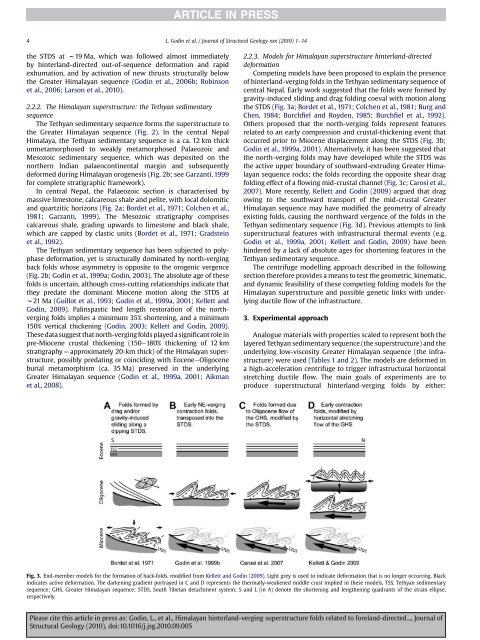Himalayan hinterland-verging superstructure folds related to ...
Himalayan hinterland-verging superstructure folds related to ...
Himalayan hinterland-verging superstructure folds related to ...
You also want an ePaper? Increase the reach of your titles
YUMPU automatically turns print PDFs into web optimized ePapers that Google loves.
4L. Godin et al. / Journal of Structural Geology xxx (2010) 1e14the STDS at w19 Ma, which was followed almost immediatelyby <strong>hinterland</strong>-directed out-of-sequence deformation and rapidexhumation, and by activation of new thrusts structurally belowthe Greater <strong>Himalayan</strong> sequence (Godin et al., 2006b; Robinsonet al., 2006; Larson et al., 2010).2.2.2. The <strong>Himalayan</strong> <strong>superstructure</strong>: the Tethyan sedimentarysequenceThe Tethyan sedimentary sequence forms the <strong>superstructure</strong> <strong>to</strong>the Greater <strong>Himalayan</strong> sequence (Fig. 2). In the central NepalHimalaya, the Tethyan sedimentary sequence is a ca. 12 km thickunmetamorphosed <strong>to</strong> weakly metamorphosed Palaeozoic andMesozoic sedimentary sequence, which was deposited on thenorthern Indian palaeocontinental margin and subsequentlydeformed during <strong>Himalayan</strong> orogenesis (Fig. 2b; see Garzanti, 1999for complete stratigraphic framework).In central Nepal, the Palaeozoic section is characterised bymassive limes<strong>to</strong>ne, calcareous shale and pelite, with local dolomiticand quartzitic horizons (Fig. 2a; Bordet et al., 1971; Colchen et al.,1981; Garzanti, 1999). The Mesozoic stratigraphy comprisescalcareous shale, grading upwards <strong>to</strong> limes<strong>to</strong>ne and black shale,which are capped by clastic units (Bordet et al., 1971; Gradsteinet al., 1992).The Tethyan sedimentary sequence has been subjected <strong>to</strong> polyphasedeformation, yet is structurally dominated by north-<strong>verging</strong>back <strong>folds</strong> whose asymmetry is opposite <strong>to</strong> the orogenic vergence(Fig. 2b; Godin et al., 1999a; Godin, 2003). The absolute age of these<strong>folds</strong> is uncertain, although cross-cutting relationships indicate thatthey predate the dominant Miocene motion along the STDS atw21 Ma (Guillot et al., 1993; Godin et al., 1999a, 2001; Kellett andGodin, 2009). Palinspastic bed length res<strong>to</strong>ration of the north<strong>verging</strong><strong>folds</strong> implies a minimum 35% shortening, and a minimum150% vertical thickening (Godin, 2003; Kellett and Godin, 2009).These data suggest that north-<strong>verging</strong> <strong>folds</strong> played a significant role inpre-Miocene crustal thickening (150e180% thickening of 12 kmstratigraphy ¼ approximately 20-km thick) of the <strong>Himalayan</strong> <strong>superstructure</strong>,possibly predating or coinciding with EoceneeOligoceneburial metamorphism (ca. 35 Ma) preserved in the underlyingGreater <strong>Himalayan</strong> sequence (Godin et al., 1999a, 2001; Aikmanet al., 2008).2.2.3. Models for <strong>Himalayan</strong> <strong>superstructure</strong> <strong>hinterland</strong>-directeddeformationCompeting models have been proposed <strong>to</strong> explain the presenceof <strong>hinterland</strong>-<strong>verging</strong> <strong>folds</strong> in the Tethyan sedimentary sequence ofcentral Nepal. Early work suggested that the <strong>folds</strong> were formed bygravity-induced sliding and drag folding coeval with motion alongthe STDS (Fig. 3a; Bordet et al., 1971; Colchen et al., 1981; Burg andChen, 1984; Burchfiel and Royden, 1985; Burchfiel et al., 1992).Others proposed that the north-<strong>verging</strong> <strong>folds</strong> represent features<strong>related</strong> <strong>to</strong> an early compression and crustal-thickening event tha<strong>to</strong>ccurred prior <strong>to</strong> Miocene displacement along the STDS (Fig. 3b;Godin et al., 1999a, 2001). Alternatively, it has been suggested thatthe north-<strong>verging</strong> <strong>folds</strong> may have developed while the STDS wasthe active upper boundary of southward-extruding Greater <strong>Himalayan</strong>sequence rocks; the <strong>folds</strong> recording the opposite shear dragfolding effect of a flowing mid-crustal channel (Fig. 3c; Carosi et al.,2007). More recently, Kellett and Godin (2009) argued that dragowing <strong>to</strong> the southward transport of the mid-crustal Greater<strong>Himalayan</strong> sequence may have modified the geometry of alreadyexisting <strong>folds</strong>, causing the northward vergence of the <strong>folds</strong> in theTethyan sedimentary sequence (Fig. 3d). Previous attempts <strong>to</strong> linksuperstructural features with infrastructural thermal events (e.g.Godin et al., 1999a, 2001; Kellett and Godin, 2009) have beenhindered by a lack of absolute ages for shortening features in theTethyan sedimentary sequence.The centrifuge modelling approach described in the followingsection therefore provides a means <strong>to</strong> test the geometric, kinematic,and dynamic feasibility of these competing folding models for the<strong>Himalayan</strong> <strong>superstructure</strong> and possible genetic links with underlyingductile flow of the infrastructure.3. Experimental approachAnalogue materials with properties scaled <strong>to</strong> represent both thelayered Tethyan sedimentary sequence (the <strong>superstructure</strong>) and theunderlying low-viscosity Greater <strong>Himalayan</strong> sequence (the infrastructure)were used (Tables 1 and 2). The models are deformed ina high-acceleration centrifuge <strong>to</strong> trigger infrastructural horizontalstretching ductile flow. The main goals of experiments are <strong>to</strong>produce superstructural <strong>hinterland</strong>-<strong>verging</strong> <strong>folds</strong> by either:Fig. 3. End-member models for the formation of back-<strong>folds</strong>, modified from Kellett and Godin (2009). Light grey is used <strong>to</strong> indicate deformation that is no longer occurring. Blackindicates active deformation. The darkening gradient portrayed in C and D represents the thermally-weakened middle crust implied in these models. TSS, Tethyan sedimentarysequence; GHS, Greater <strong>Himalayan</strong> sequence; STDS, South Tibetan detachment system; S and L (in A) denote the shortening and lengthening quadrants of the strain ellipse,respectively.Please cite this article in press as: Godin, L., et al., <strong>Himalayan</strong> <strong>hinterland</strong>-<strong>verging</strong> <strong>superstructure</strong> <strong>folds</strong> <strong>related</strong> <strong>to</strong> foreland-directed..., Journal ofStructural Geology (2010), doi:10.1016/j.jsg.2010.09.005
















